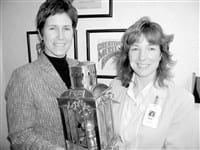Getting Their Message Across Award-winning SPHS Ad Campaigns Stress Compassion — And Technology
The Sisters of Providence Health System (SPHS) came home with a number of honors from the New England Society for Healthcare Communications awards ceremony in October, including the ‘best in show’ prize, the Lamplighter Award, for its Mercy Medical Center billboard campaign.
Thus, one section of wall in the Community Relations and Marketing offices in the Memorial Building is now covered with framed awards, and the staff has had to find a place to put the two-foot-high brass lamp that is the top award.
The hardware is nice, said Trish Perrault, director of marketing for the SPHS, but the real measure of an ad campaign’s worth is its ability to help a health system improve its visibility — and its bottom line. And the various components of the SPHS strategy have been able to do just that, she said, noting that the system has methods to quantify and qualify the success of its efforts.
For starters, there are increases in volume for many of the system’s programs — everything from hearing clinics to mammograms. There are the surges in phone calls to various offices after print and TV spots appear, and rising numbers of hits on the system’s Web site, www.mercycares.com, said Perrault.
But then, there are some harder-to-quantify benefits, such as staff morale and goodwill within the community.
“Many employees tell us that when they see our billboards or our television ads, they feel proud to work for the system,” she told The Healthcare News, adding that ads also make the system more attractive to health care professionals looking for career opportunities. “Those aren’t things you necessarily think about when you create a billboard, but they’re there, and they’re real, and they’re part of what makes a message work.”
Susan Fenelon Kerr, SPHS director of community relations, said the advertising and marketing efforts — now done entirely in-house — are designed to highlight not only the system’s compassionate, or high-touch, character (something that has always been stressed), but also its high-tech capabilities. This is a necessary element in today’s health care market, she said, as technology continues to improve and consumers become increasingly sophisticated about the care they want and need.
“People always knew we were compassionate,” she explained. “Now, they know we also have state-of-the-art technology.”
As part of its focus on health care marketing, The Healthcare News looks at the SPHS marketing and community relations strategies, and how they have helped the system achieve growth at a very challenging time for the health care industry.
On-the-spot Analysis
For the record, the SPHS took home five awards at the NESHCO ceremony, an event that recognized the best of more than 300 entries from health care facilities that included Baystate Health System (which also copped several awards), the Leahy Clinic, Yale-New Haven Hospital, Children’s Hospital in Boston, UMass Medical School, and several ad agencies. Awards were given based on both the creative elements in entries and their success in generating business.
The SPHS awards included:
• First place in Outdoor Advertising and best in show for Mercy Medical Center’s 2002-03 billboard campaign;
• First place in Advertising, Total Campaign, for Mercy’s Comprehensive Weight Management Program;
• An ‘award of excellence’ for Advertising, Print Campaign, for Mercy’s Pediatric Urgent Care Center, which provides pediatric services on weekends and at night; and
• An ‘award of excellence’ for Internal Publications, for SPHS’s employee newsletter, the Sisters of Providence Health System Journal, which is distributed to more than 4,000 employees and volunteers.
Perrault said these are just some of the many components of the system’s broad marketing and community relations strategy. The SPHS also has an effective Web site, a wide array of television spots, direct mail, and a host of programs within area communities to improve visibility and help improve the quality of life for residents of the region.
Perrault said the health system uses a variety of media to get its various messages across, including television, print ads, billboards, and internal publications. Each medium is chosen for both the message it can carry and the audience it can reach.
Newspaper ads, for example reach a large audience and can contain a detailed message, said Perrault. Thus, many of the system’s print ads are used to promote educational programs and introduce new products and services, such as digital mammography and Mercy’s new DEXA system of advanced bone assessment.
Print ads have also been used to inform the public of Mercy’s $8.6 million, 13,000-square-foot expansion of the Sr. Mary Caritas Cancer Center, and to introduce the 2004 ‘Weldon Ambassadors,’ those individuals who demonstrate courage and dedication in the course of rehabilitating from illness or injury at the system’s Weldon Center for Rehabilitation.
Billboards, which should be limited to five words or less in their message, can’t do what print or television ads can, said Perrault, but they can reinforce a message and build visibility and name recognition.
She said the billboards — located on I-91 in downtown Springfield and just over the Connecticut River, on Route 291 in Indian Orchard, and on Route 20 in West Springfield — are rotated, and designed to drive home the system’s main themes — comprehensive, compassionate care and state-of-the-art technology.
One billboard, for example, has the Mercy name and the word EXPERTS above it, with the letters E and R highlighted to focus on the medical system’s emergency room services. A similar board simply has the word MERCY, with the E and R again highlighted.
Another billboard, designed to promote the Weldon Center adds two letters to that name and comes up with WELLDONE. Still another board has the word QUALITY, with the numeral 1 in place of the letter I. Other billboards, not part of the set that won the NESHCO award, use simple images such a toy elephant and a boy on a skateboard to promote the Pediatric Urgent Care Center, which was introduced a year ago.
“Some people didn’t know we had such a program,” said Perrault, stressing that the billboard can’t tell the whole story, but it can create awareness. “You’re not selling with billboards — you sell later — but you reinforce the message.”
Often, a package of media are used to promote a specific product or service, Perrault added, citing the example of digital mammography. Billboards are used to build awareness of the technology, while print and television ads are used for education.
“In our TV ad, we’ve incorporated public awareness about mammography — that women over the age of 40 should have an annual exam,” she said. “This was a message we were trying to get across, because statistics show that one in three women in Springfield who should be getting screened are not getting mammograms.”
It’s News to Them Fenelon Kerr and Perrault told The Healthcare News that one key to creating an effective marketing campaign is to involve leadership and members of the system’s many departments in the process.
“We work with leadership within the organization and managers to identify priorities for the system,” Perrault said, adding that there are both constants — programs, services, and institutional messages that need to be promoted on a constant basis — as well as varying priorities.
For example, a few years ago, the system’s maternity department, the Family Life Center, was heavily promoted because it was a new service that needed to be introduced to the region. That facility has achieved significant name recognition and a solid reputation, said Perrault, noting that other priorities, such as the Pediatric Urgent Care Center and new technology like Mercy’s Lightspeed CT scanner and digital mammography have emerged.
By involving other departments in setting priorities, the system can make the most effective use of its marketing budget, she explained, adding that input can also make a specific ad or ad campaign more effective.
“When there’s something that’s designed, we’ll go around and ask for feedback from different departments,” said Perrault. “We’ll ask maybe 15 or 20 people their opinions on the materials. It may be on the creative side or the marketing side — we’re seeing it one way, and someone may have some input that will influence us and have us say, ‘gee, I never thought of that.’”
There is also give and take on the various mediums used to deliver a specific message, she said.
“Sometimes, departments may see TV commercials as being the avenue to reaching their audience,” she explained. “When they come and meet with us, and we talk about how best to reach that audience, they may find that direct marketing is the best way to go.”
Another component of any successful marketing campaign is internal communication, said Fenelon Kerr, who told The Healthcare News that the system’s 4,000 employees, physicians, and volunteers form an important constituency.
This group needs to be informed, she said, but also entertained in some ways, as well as inspired and made to feel proud of the system’s team. The retooled in-house monthly publication, the Sisters of Providence Health System Journal, which Fenelon Kerr edits, is designed to handle all those assignments.
It has hard news, including front-page stories on the cancer center expansion, the employees’ annual fund drive, the Weldon ambassadors, and the 130th anniversary of the ministry of the Sisters of Providence in Western Mass., but also a number of people-oriented features. These include an employment-spotlight section that profiles workers from across the system, a calendar of events, and a section on staff additions and promotions.
The Journal also devotes a page each month to the system’s Values in Practice (VIP) initative, a broad-brush program designed to involve all employees in continuous improvement strategies.
“We have a large system, with facilities in a number of area communities, and a lot of employees,” said Fenelon Kerr. “We use the Journal and other in-house communication initiatives to make people feel they’re part of one system.”
Lighthearted Messages
Perrault said the staff in community relations and marketing plan to enter more of their work in next year’s NESHCO competition.
If this year’s success is any indication, more of the second-floor wall space will be devoted to plaques and awards. But as she said, the true measure of a marketing strategy isn’t the number of awards it wins, but its overall effectiveness in getting a message across.
In that respect, the SPHS strategies are shedding light in both both a literal and figurative sense.




Comments are closed.